
REVIEW – Sterilization is all the rage these days. Soap and water, hand sanitizer, steam cleaning – anything to get rid of pesky germs and viruses. The latest weapon in the germ wars is ultraviolet light. Ultraviolet (UV) light is electromagnetic radiation with wavelengths between 100nm (nanometers) and 400nm. I should say “for home” as UV light has been used in labs and industrial applications for years.
UV light in the 315nm – 400nm range is canned UV-A light. Many of us of a certain age are familiar with UV light from backlights – that purple/blue light that makes things glow. That is 365nm and falls into the UV-A spectrum, as does about 95% of the UV light produced by the sun. It is used in tanning beds and other industrial uses. UV-B light runs from 280nm-315nm and can cause sunburn, but doesn’t damage DNA. The shortest wavelength UV light, UV-C, is also the most powerful, falling in the 100nm – 280nm spectrum. This spectrum is completely filtered out in sunlight by the Earth’s atmosphere and has to be artificially produced. It can harm organisms, including microorganisms. It penetrates the DNA and ultimately causes the organism to die. When we’re talking about germs and microorganisms, that’s a good thing.
Let’s take a look and see if the Coral UV 3-in-1 sterilizer is a bright idea.
What is it?
The Coral UV 3-in-1 sterilizer is a plastic-covered, metal-lined box. Inside the lid are two lamps that produce UV-C light with enough intensity to sterilize anything in the box. Also, the Coral UV can dry damp items and maintain items in a sterile state for up to 24-hours.
What’s in the box?
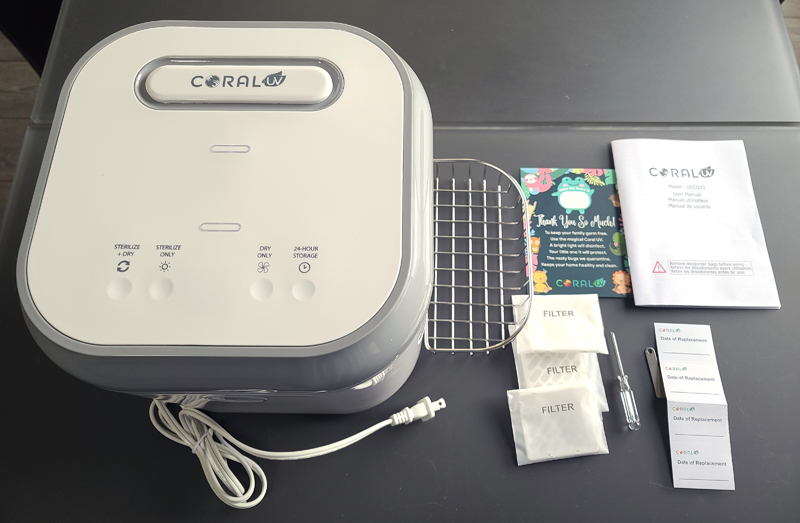
- Coral UV sterilizer with bulbs installed
- Small-item tray
- Thank-you card
- User manual
- Three replacement HEPA filters (one is installed)
- Screwdriver to remove HEPA filter cover
- Filter removal tool
- Filter change reminder stickers (4)
Hardware specs
- Dimensions: 10.5 inch (L) x 10.5 inch (W) x 10 inch (H)
- Internal dimensions: 10 inch (L) x 8 inch (W) x 7.5 inch (H)
- Net weight: 5.7 lbs
- Electrical spec: 120V, 60Hz, 55W
- Power cord length: 1.5 meter / 59 inches
- UV-C disinfection lamp: 2 lamps at 4 watts each, wavelength 253.7nm
- UV-C lamp model: Philips TUV 4W FAM G5 Cap
- Modes:
- Sterilize + dry – 30/40/50/70 minutes drying + 10 minutes UV-C
- Sterilize only – 10/15/20 minutes UV-C
- Dry only – 30/40/50/60 minutes drying
- 24-hour storage – 40 minutes drying + 10 minutes UV-C + 2 minutes UV-C every 2 hours for up to 24 hours
Design and features
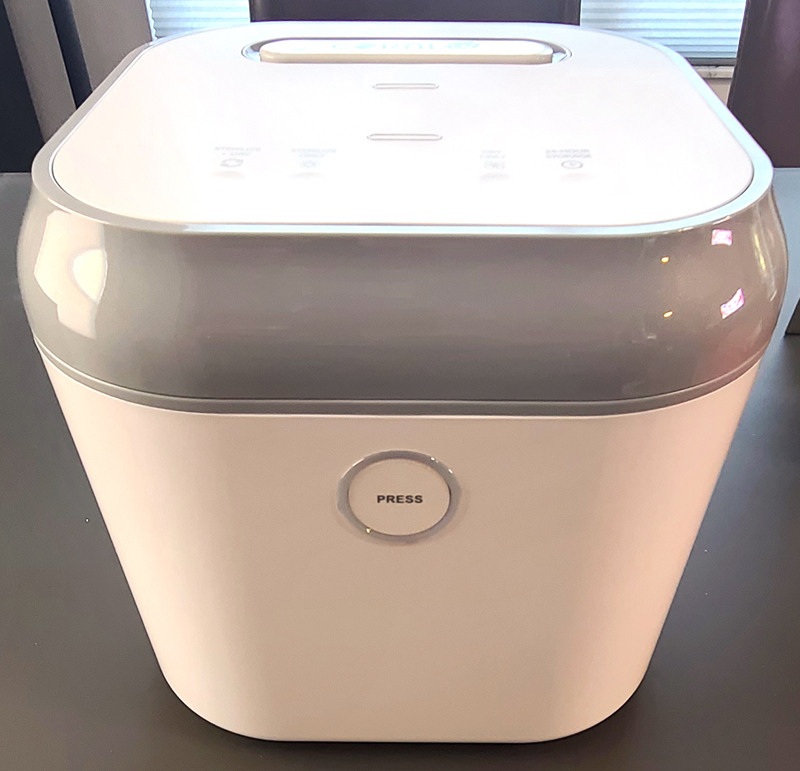
The sterilizer is a pretty big white plastic-covered box with a hinged lid. The accent color is a creamy gray.
The “PRESS” button on the front opens the lid and doubles as an indicator that it is running.
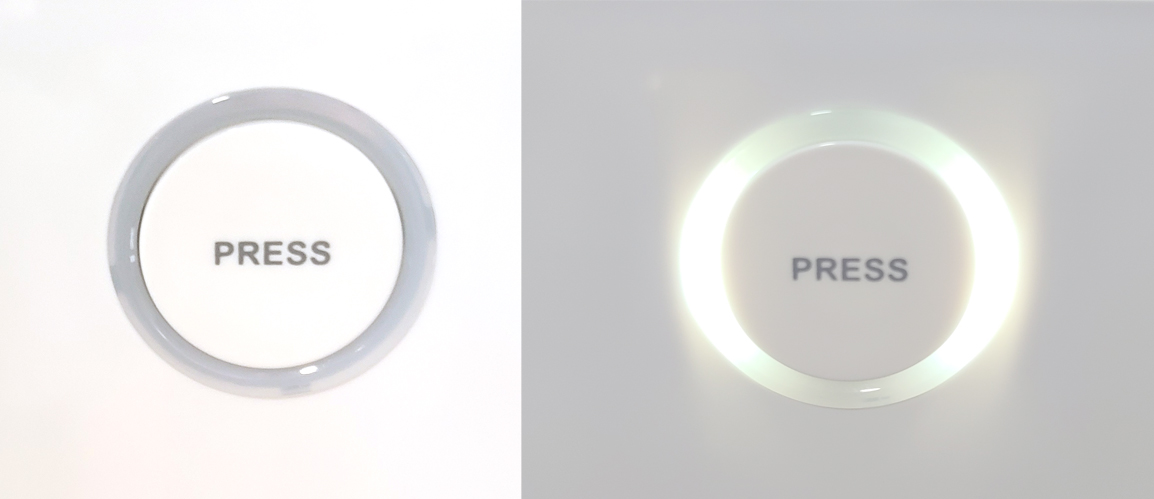
On the back, we find the lid hinge and power cord as well as the HEPA filter cover.
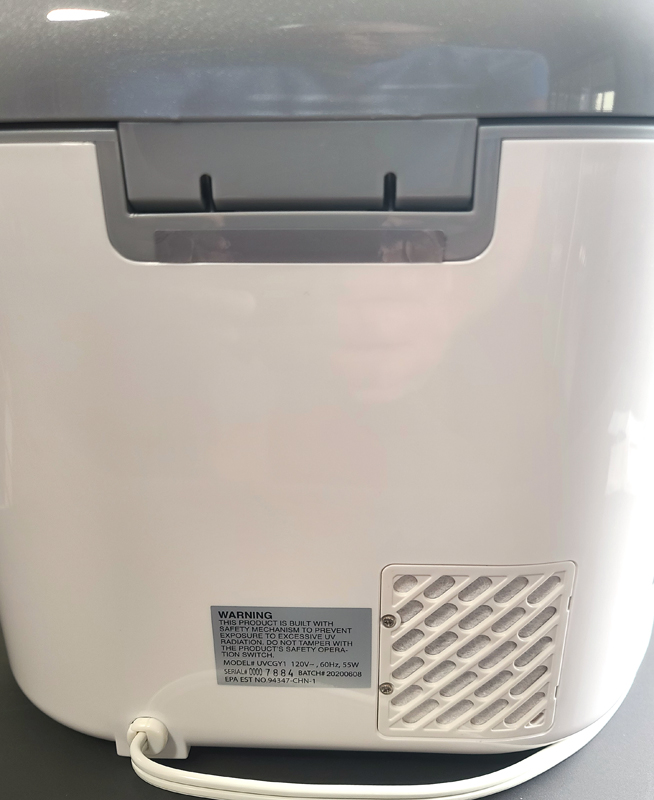
The cover is held in place with two screws. While it’s nice they include a screwdriver, it would be much nicer if the cover opened with a no-tool-needed clip.
The two UV-C lamps are installed inside the lid.
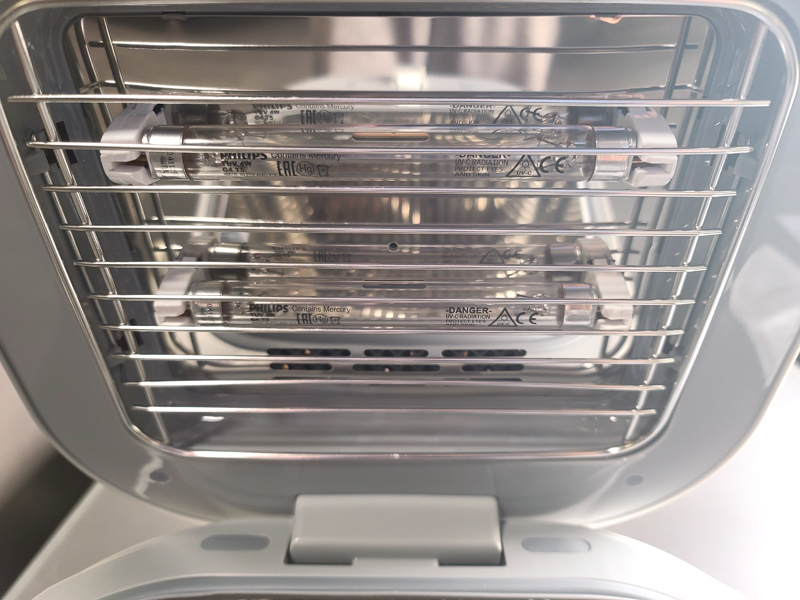
The interior of the box is lined with highly polished and reflective stainless steel. This ensures that the UV-C light emitted from the lamps bounces all around inside the chamber so it gets to all surfaces of the items in the chamber. On the back bottom right, you can see the vents for the HEPA filter.
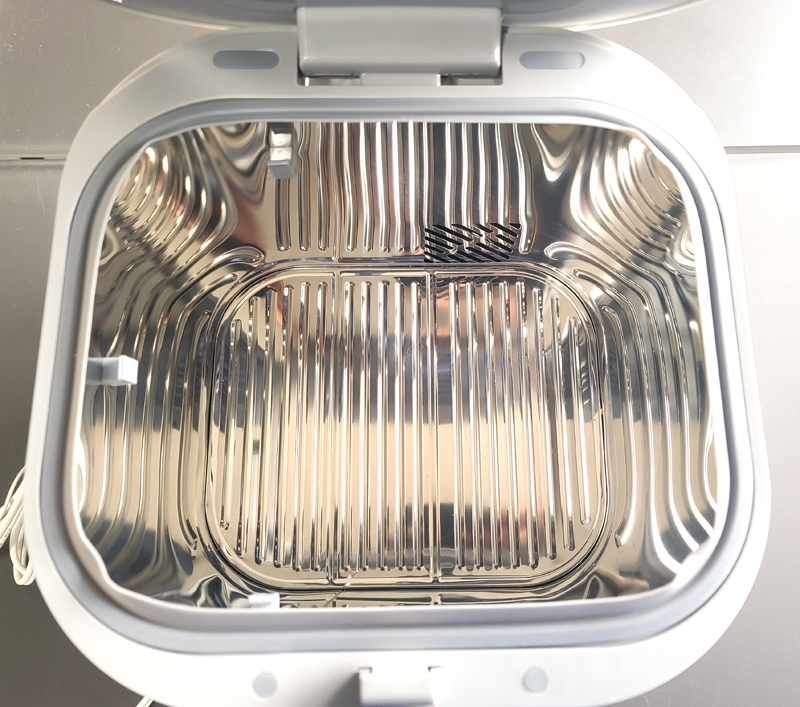
The included wire tray mounts on tabs inside the top of the chamber. On the left, you can see the three tabs that hold the tray. On the right, we see the tray installed.
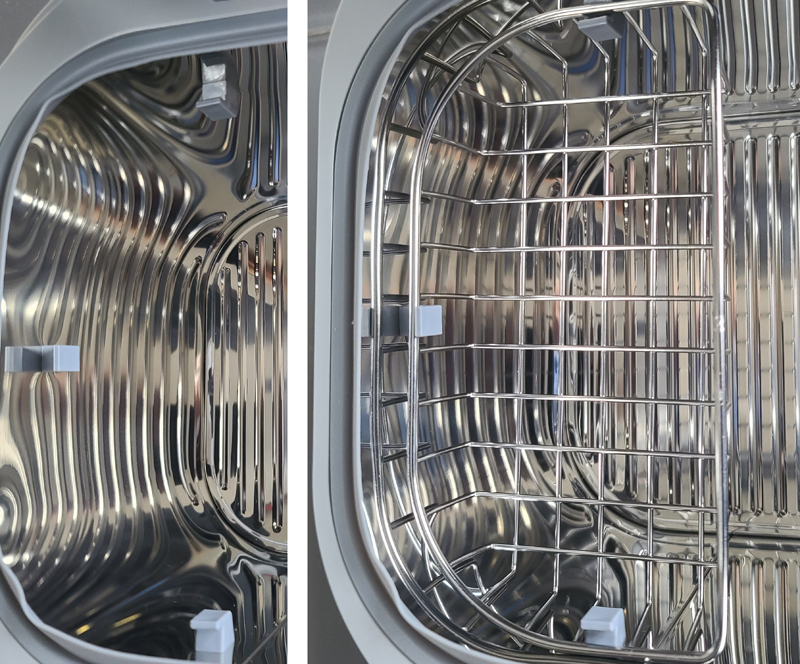
The controls are located on the top of the lid.
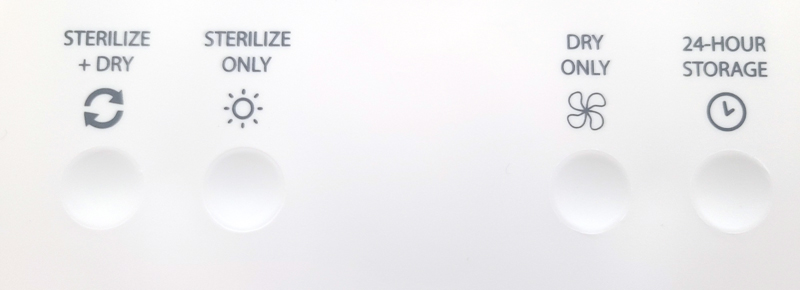
The depressions under the labels are touch-sensitive switches. Touching one selects or cancels that operating mode. Touching multiple times rotates through the available times for each operating mode.
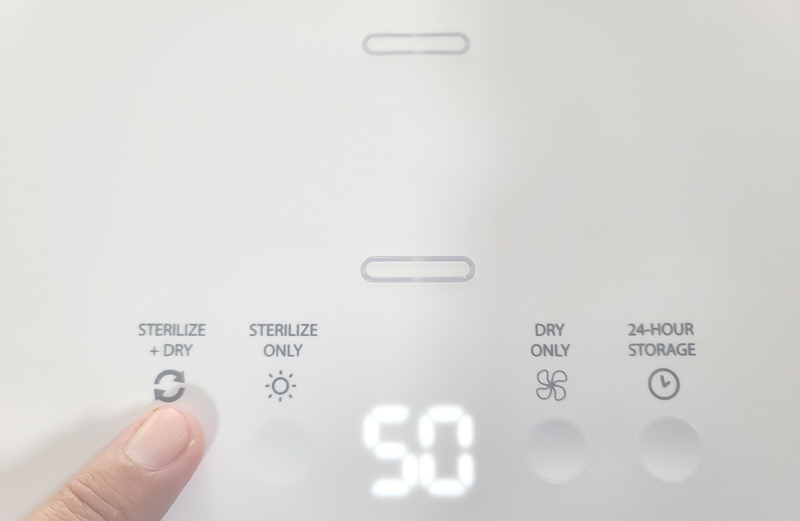
The timer lights up in the center, and yes, the digits are really that blurry.
When the UV-C lamps are lit, the two indicators on the lid glow blue.
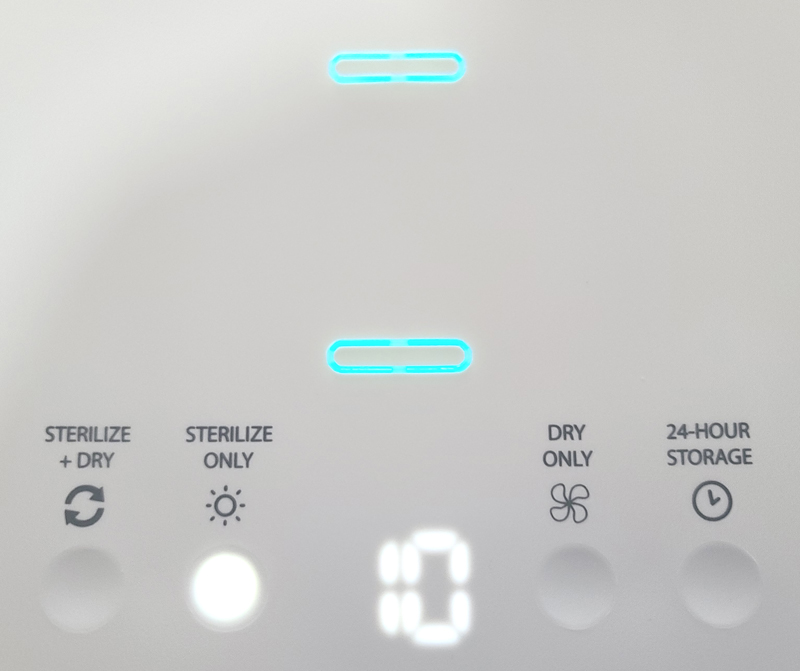
The remaining time in the cycle show on the display.
If the lid is opened mid-cycle, the UV-C lamps are immediately shut off for safety and two dashes replace the time indication.
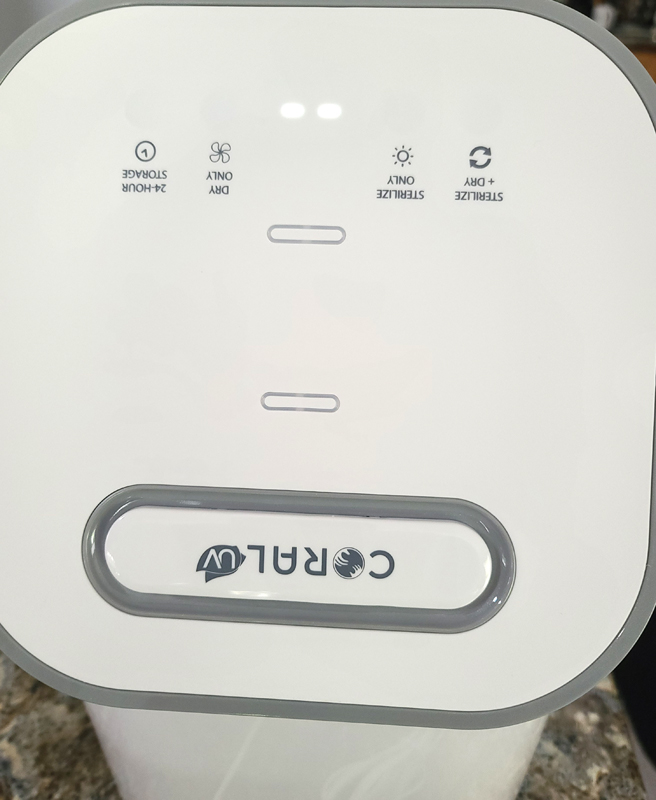
You can close the lid and the session will continue.
Setup
Other than wiping out the interior, there isn’t any setup. The lamps and the HEPA filter are already installed. If you have small items to sterilize, you can install the small tray, so I guess that counts as setup.
Performance
Let’s talk for a moment about UV-C sterilization. According to its website, Coral UV has undergone third-party lab testing and has shown that it eliminates E. Coli, Salmonella, Staph, and more. According to the FDA’s website, while UV-C has proven effective against SARS-Coronavirus, a different virus from the current SARS-CoV-2 (COVID-19) virus, there isn’t enough data to definitively say that it will deactivate COVID-19. But, the FDA says that it may deactivate the virus.
You need to be aware of what each mode does with the Coral UV. The sterilization mode uses only UV-C light to sterilize whatever you put in the chamber. That makes it safe for just about any item you put in, including electronics like cell phones, and remotes.
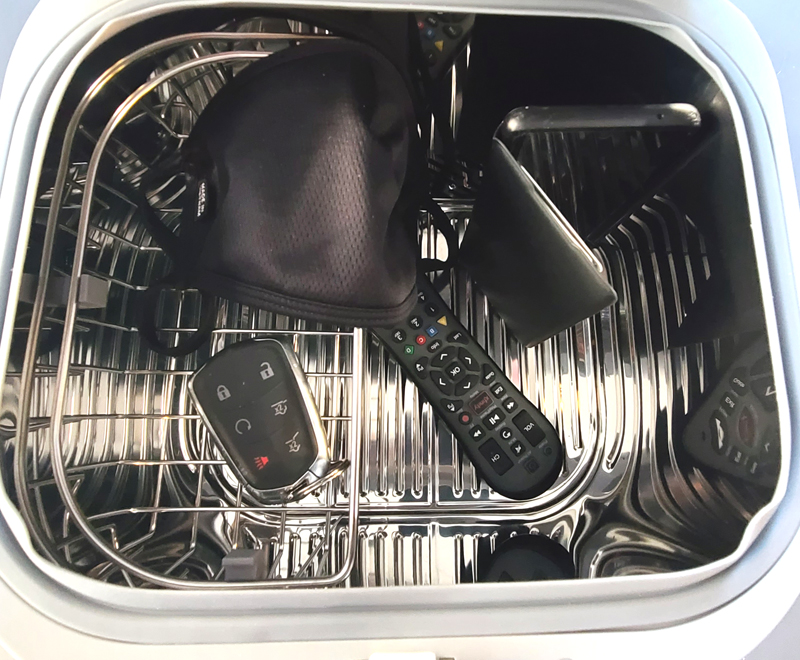
In the photo above, you can see that I sterilized a TV remote, car remote, cell phone, and mask.
When using the drying modes, be aware that heat is involved, so this is not suitable for electronics. I washed a plastic glass and shook off the excess water.
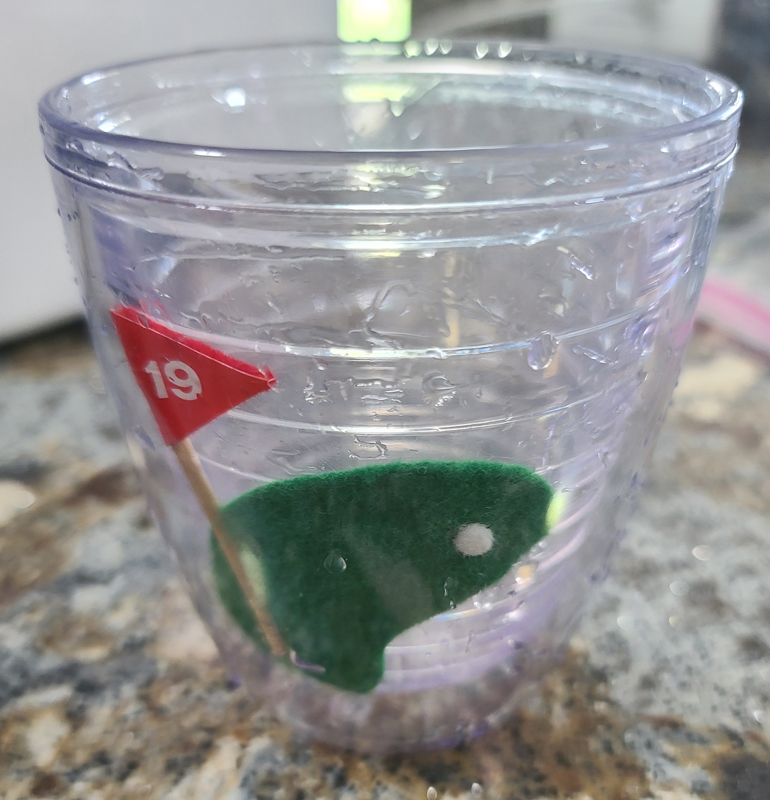
The instructions say to place glasses and bottles upright in the chamber. I did that and ran the 50-minute dry+sterilize program that dries for 40 minutes and then sterilizes for 10. During drying, you can hear a fan whirring, pulling the moisture out of the chamber through the HEPA filter. The heat level is safe for glass, plastic, and silicone. It beeps when the cycle is complete.
At the end of the session, the glass was almost dry – note the red circle – one pesky water drop remained. I’d wager that the 60-minute cycle would have handled that.
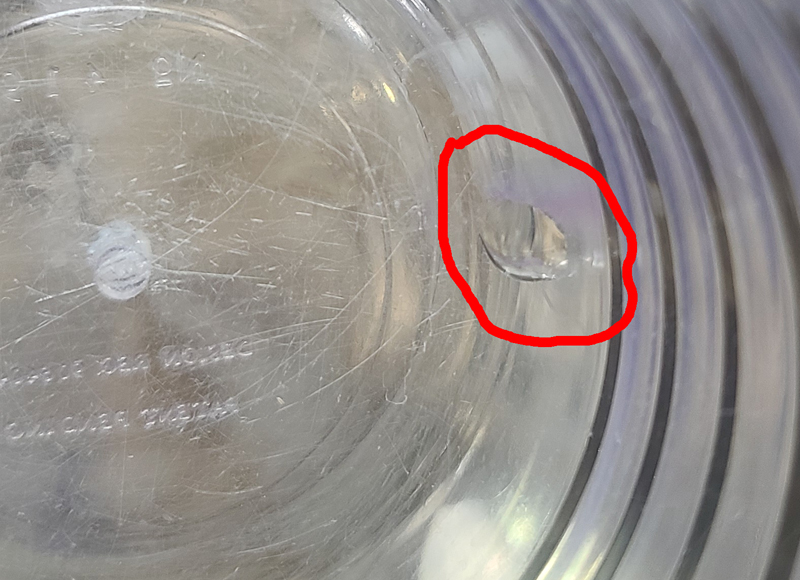
So, who would want something like this? First, anyone that wants to sterilize everyday items. Picture this: come home from work, drop your wallet, car keys, cell phone, pen, pocket knife, eyeglasses – your whole EDC kit – in the chamber and start the sterilization routine. In 10 to 20 minutes, your everyday carry items are sanitized and germ-free. Nice.
I see a much larger draw for parents of young children. The chamber is sized to hold six baby bottles plus caps and nipples. With the 24-hour storage mode, you can wash bottles at night and have them dried and continuously sterilized for the next day. After cleaning small stuffed animals or toys, you could easily dry and sanitize them in the Coral UV.
The lamps are expected to last about a year in normal use. They are available from Coral UV for $15.99 per pair. The HEPA filters are good for three months and are available for $6.99 for four filters. That puts the annual operating cost not counting electricity at just under $23. That’s pretty reasonable and a lot more convenient than putting sanitizer all over everything.
What I like
- Easy to use
- Large capacity
- Nice selection of modes and times
- Good consumable life and reasonable replacement cost
What I’d change
- Change the design of the HEPA filter cover so a screwdriver (or any tool) isn’t needed to open it
- Make the timer digits a little less blurry
Final thoughts
People are painfully aware of the need to sanitize, given the crazy state of the world at the moment. Coral UV offers a practical and safe way to get lab-quality results at home. All-in-all, I see that as a good thing. With its reasonable price and inexpensive consumables cost, Coral UV makes a pretty compelling potential home solution for sanitizing small items.
Price: $149.99
Where to buy: Coral UV and Amazon
Source: The sample of this product was provided by Coral UV.


